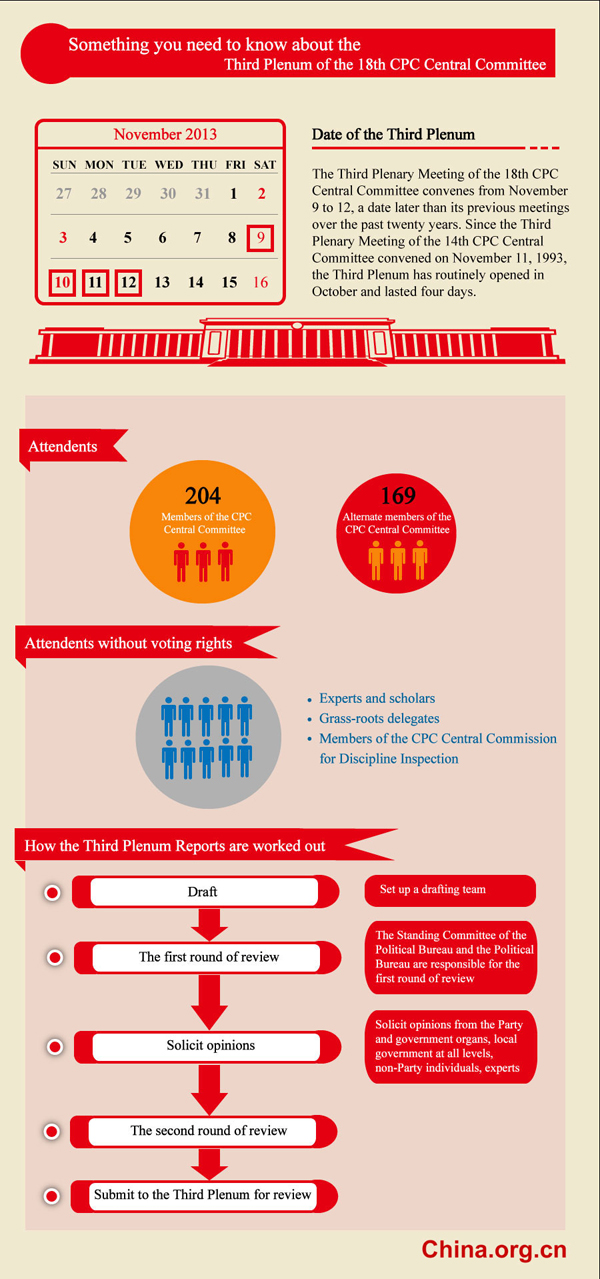Accusations about China's Third Plenum unjustified
- By Liu Qiang
 0 Comment(s)
0 Comment(s) Print
Print E-mail China.org.cn, November 15, 2013
E-mail China.org.cn, November 15, 2013
The media of the world has been busily discussing the communiqué of the Third Plenum of the 18th CPC Central Committee after the conclusion of the four-day closed-door meeting on Nov.12, but has left some blaming the meeting for not being transparent enough.
There have been hasty presumptions since the start of the meeting from some foreign media that the Third Plenum of the Chinese Communist Party's 18th Central Committee "will not signal any change in the party's time-honored practice of cloaking such gatherings in bizarre mantles of secrecy ." Some have doubted whether serious debates took place there.
While it is true that the some details of four-day meeting have not been disclosed, some of the accusations about it have been absurd.

Historically, China's Third Plenums have been the key gatherings of Chinese leaders to present their long-term visions for the country's development path. According to tradition, the meeting is always held behind closed doors, and the details of the debates during the plenum are not revealed.
The Third Plenum this year brought together over 400 of the country's most powerful officials for intense discussion, including 148 officials from local governments, 18 from state-owned enterprises and financial institutions, 12 from social organizations and 9 from academies.
The 5000-character communiqué is only a glimpse of a lengthy process of serious debate and discussion.
Starting this July, the seven members of the Political Bureau's Standing Committee carried out extensive field research nationwide to listen to grassroots opinions. President Xi Jinping visited nine provinces in ten field research projects since the conclusion of the 18th National Congress of the CPC last November. From Nov. 3 to Nov. 5, just days before the Third Plenum, President Xi visited Hunan Province in Central China where he emphasized that China must deepen reform and push forward innovation to complete the social and economic development goal for this year.
On Oct. 29, the CPC Political Bureau met to review the draft version of The CPC Central Committee's Decision on Several Major Issues on Comprehensively Deepening Reform (the Decision), the final version of which was adopted during the Plenum.
Besides, non-communist parties were also consulted for their opinions. On Sept. 17, the CPC Central Committee held a symposium to listen to comments and suggestions from non-communist parties, the All-China Federation of Industry and Commerce, as well as people without party affiliation regarding the Decision. The symposium was presided over by President Xi Jinping.
According to Hu Angang, director of the National Conditions Research Institute at Tsinghua University, it took nearly two years to draft the decision, in two phases. The first phase was a one-year process of drafting the Report of the 18th National Congress of the CPC which was adopted last November. The Report clarified the overall goal, the basic principles and major tasks for the Decision. Since the adoption of the Report, China's new leadership started drafting the Decision which will be the guideline for China's socialist development and deepening reform over the next ten years.
The Decision is the outcome of a painstaking process of soliciting opinions and drafting and redrafting, which is a formidable task in a country with a population of more than 1.3 billion. The Decision proved that China's decision-making mechanism is highly effective.
The Plenum has marked the start of a new round of unprecedented reforms in China. A more positive approach would be to anticipate the direction of China's development, rather than jump to early conclusions.






Go to Forum >>0 Comment(s)